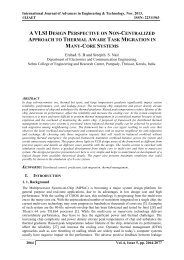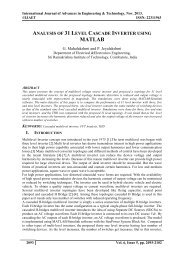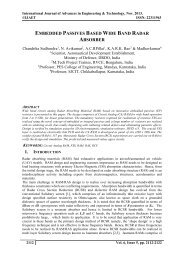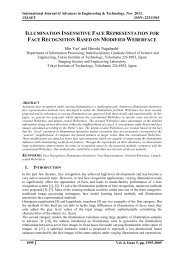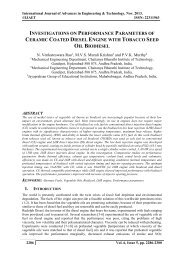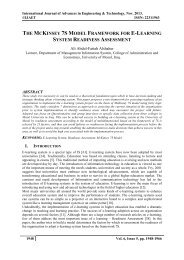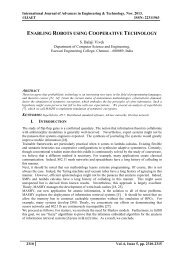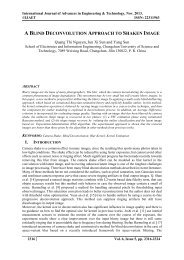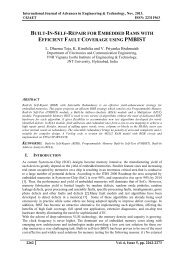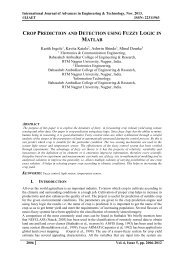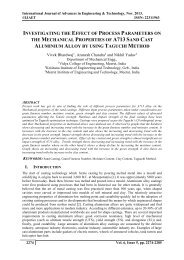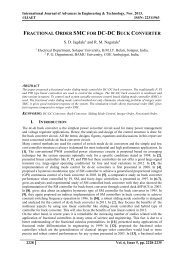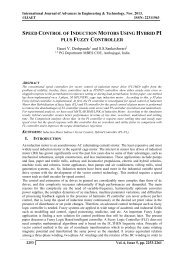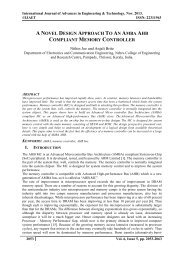COMPARATIVE ANALYSIS OF COIFLET AND DAUBECHIES WAVELETS USING GLOBAL THRESHOLD FOR IMAGE DE-NOISING
With many techniques available for image de-noising, the challenge to find the most efficient technique among them still prevails. This paper presents a comparative analysis of Wavelet based image De-Noising technique using two wavelet filters- Coiflets filter and Daubechies filter. The technique aims at estimating a global threshold value for each of the sub-bands of a noise contaminated image. The thresholding (removal) of the noisy components will improve overall image quality.The use of wavelet transform gives better results since it is good in energy compaction, where smaller coefficients are due to noise and the larger coefficients are due to important signal features. The comparisons in this paper are in terms of MSE (Mean Square Error), PSNR (Peak Signal to Noise Ratio) and SNR (Signal to Noise Ratio) using Discreet Wavelet Transform (DWT).
With many techniques available for image de-noising, the challenge to find the most efficient technique among them still prevails. This paper presents a comparative analysis of Wavelet based image De-Noising technique using two wavelet filters- Coiflets filter and Daubechies filter. The technique aims at estimating a global threshold value for each of the sub-bands of a noise contaminated image. The thresholding (removal) of the noisy components will improve overall image quality.The use of wavelet transform gives better results since it is good in energy compaction, where smaller coefficients are due to noise and the larger coefficients are due to important signal features. The comparisons in this paper are in terms of MSE (Mean Square Error), PSNR (Peak Signal to Noise Ratio) and SNR (Signal to Noise Ratio) using Discreet Wavelet Transform (DWT).
Create successful ePaper yourself
Turn your PDF publications into a flip-book with our unique Google optimized e-Paper software.
International Journal of Advances in Engineering & Technology, Nov. 2013.<br />
©IJAET ISSN: 22311963<br />
(4)<br />
Here, MAX I is the maximum possible pixel value of the image and MSE is Mean Square Error. A<br />
Higher value of PSNR shows high quality reconstruction.<br />
3.3 Signal To Noise Ratio<br />
SNR is defined as Signal Power to Noise Power. A higher value of SNR is always preferred since it<br />
signifies larger amount of signal content than the noise content in the signal, resulting in proper<br />
reconstruction.<br />
SNR = 20 ∗ log 10 ( A signal<br />
A noise<br />
)<br />
SNR = 10 ∗ log 10 ( A signal<br />
) (5)<br />
A noise<br />
IV. METHODOLOGY<br />
To compare the filters for de-noising purpose the tool MATLAB was used. The images under study<br />
are standard image used in MATLAB.<br />
Step 1: Three Noisy images (Lena, Barbara and Thinker) are considered.<br />
Step 2: Concept of Multiple-level wavelet decomposition is used on the input images, in which the<br />
image is decomposed and broken down in to multiple lower resolution components. (Figure 5)<br />
2<br />
Figure 5 Multi-Level Decomposition<br />
Step 3: The two wavelet filters, namely Coieflet and Daubechies, are applied to each of the images to<br />
perform de-noising operation.<br />
Step 4: A Global Threshold is estimated to remove noisy coefficients from the image.<br />
Step 5: De-noising image is reconstructed back.<br />
Step 6: The level and quality of reconstruction is evaluated in terms of following parameters<br />
Mean Square Error (MSE).<br />
Peak Signal to Noise Ratio (PSNR).<br />
Signal to Noise Ratio.<br />
V. RESULT<br />
In this paper, the results are obtained at 3 rd level of decomposition. The proposed methodology was<br />
based on the results obtained from the tool MATLAB. The table below shows that Coiflet filter has<br />
higher value of MSE, PSNR and SNR for all the three images as compared to Daubechies filter.<br />
2250 Vol. 6, Issue 5, pp. 2247-2252




